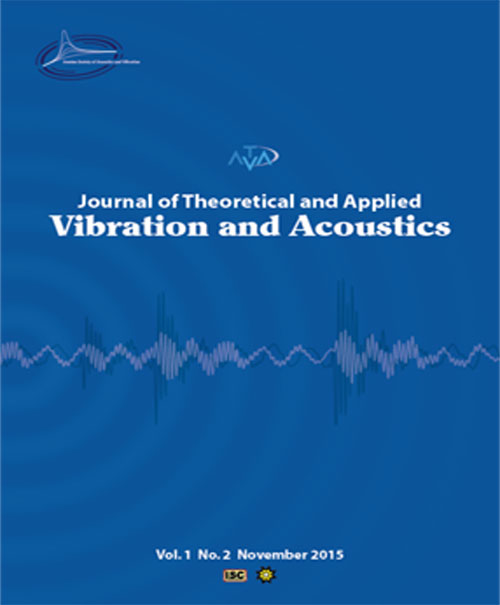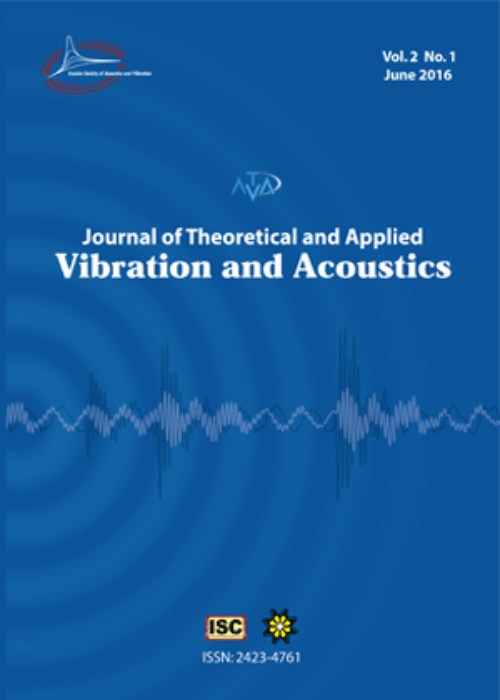فهرست مطالب

Journal of Theoretical and Applied Vibration and Acoustics
Volume:1 Issue: 2, Summer & Autumn 2015
- تاریخ انتشار: 1394/09/21
- تعداد عناوین: 6
-
-
Pages 62-72In this paper, the transverse vibration of a triple-walled carbon nanotube (TWCNT) conveying fluid flow is studied based on the strain/inertia gradient theory with van der Waals interaction taken into consideration. The nanotube is modelled using Euler-Bernoulli beam model and the Galerkin’s method is employed to obtain the CNT complex valued Eigen-frequencies. The effects of the fluid flow thorough the innermost tube and the van der Waals force interaction between any two walls on the instability of the nanotube are studied. In addition, the effects of the nano-flow size, the characteristic lengths and the aspect ratio on the critical flow velocities are investigated. Results indicate that due to the fluid flow the nanotube natural frequencies decrease. By considering the size effect of the fluid flow, frequencies decrease more rapidly causing reduction of the stability region. Moreover, it is shown that the length of the nanotube can play an important role in the vibration response.Keywords: Triple, walled carbon nanotube, Knudsen number, Strain, inertia gradient theory, Galerkin's method
-
Pages 73-84A semi-analytical method is used to illustrate the behavior of a multimodal nonlinear electromechanical system which is under base-excitation. System is considered as piezo-ceramic patches attached to a cantilever beam coupled to a resistive load. The cantilever beam is modeled as a nonlinear Timoshenko beam using Assumed Mode method and equations of motion are derived through Lagrange's equation. Nonlinear multimodal equations are solved with Complexification Averaging method and results are compared with numerical simulations. Arc length Continuation method is used to achieve frequency response of the system. Results are presented for different values of geometric and physical parameters and the effect of this variations are discussed.Keywords: Nonlinear energy harvesting, Multimodal duffing oscillator, Complexification averaging method, Arc length continuation method
-
Pages 85-95Dynamic response analysis of mechanical structures is usually performed by adopting numerical/analytical models. Finite element (FE) modeling as a numerical approach plays an important role in dynamic response analysis of complex structures. The calculated dynamic responses from FE analysis are only reliable if accurate FE models are used. There are many elements in real mechanical structures which make constructing accurate FE models difficult. For example, modeling the boundary supports of mechanical structures are usually challenging because of the uncertainties existing in their stiffness values. The stiffness values of boundary supports can be identified by using experimental natural frequencies and hence the FE model can be corrected. In this paper, the FE modeling and updating of propulsion shaft lines in a ship structure is considered by employing experimental modal parameters, i.e. natural frequencies. Natural frequencies of shaft lines are measured by performing experimental vibration testing. The corrected FE models are used and dynamic response analysis of shaft lines is conducted.Keywords: FE modeling, Shaft line, Vibration measurement, Updating, Campbell diagram
-
Pages 96-106In this paper, an iterative technique is proposed to solve linear integrated active/passive design problems. The optimality of active and passive parts leads to the nonlinear algebraic Riccati equation due to the active parameters and some associated additional Lyapunov equations due to the passive parameters. Rather than the solution of the nonlinear algebraic Riccati equation, it is proposed to consider an iterative solution method based on the Lyapunov equations in the Newton optimization scheme for both active and passive parameters. The main contribution of the paper is considered as the concept that it doesnt require to optimize controller when the plant is not optimal. The proposed method is verified by designing a one-quarter active suspension system. The results indicate that the algorithm is more efficient as compared to solving the problem through the direct Riccati solution based method while its derivation and application is simple. Significant improvements can be seen in comparison to the previous method.Keywords: Integrated active, passive design, Suspension system, Optimal control, Riccati equation, Lyapunov equation
-
Pages 107-121Existence of outflow intrusion introduces small-scale turbulence that perturbs the vertically stratified character of the sound velocity and causes spatial and temporal fluctuations of the sound propagation. In this experimental study, we have investigated acoustic wave propagation with frequency of 50 kHz in a pre-stratified environment with intrusion of a turbulent plume while the signals received in different locations and times are recorded. At first, a fourth-order Butterworth band-pass filter was applied to the received voltage time series. Then the signals received at different times when entering the outflow intrusion at similar depths are compared to the ones without plume intrusion. In order to investigate the shapes of the signals received at different moments of the experiment they are analyzed in the time domain using trace envelope techniques. The results show that if the transmitter is positioned in the outflow intrusion location, the received signals in the upper and lower part of the outflow intrusion show a signal amplitude increase but the received signals in the dyed outflow show a signal amplitude decrease. Thereby, results indicate that the outflow intrusion could be important in shapes of the received signals. Also we have observed the occurrence of major signals fluctuations over time is accordance with the sound speed vertical structure changes due to the intrusion development.Keywords: Pre, Stratified, Environment, Outflow intrusions, Sound propagation, Trace envelope, Signal fluctuations
-
Pages 122-132In this paper the influence of non-acoustic properties on the sound absorption coefficient of polyurethane foams as a porous medium is investigated. Biot’s equations with transfer matrix method, as the solution approach are employed to evaluate the sound absorption coefficient of selected polyurethane foams. The major issue is the dependency of non-acoustic properties on each other which makes difficulties to examine the effect of parameters individually. Some facts from the results of previous works are used in order to overcome this prominent obstacle. The results show that increasing the porosity doesn’t have a great influence on the sound absorption coefficient and only for highly porous foams, raising porosity decreases the sound absorption performance. The increase of air flow resistivity up to an optimized value, intensifies the absorption capability. Furthermore, for partially reticulated (partially open cell) foams, the increase of tortuosity improves the sound absorption efficiency at lower frequencies.Keywords: Porous media, Polyurethane, Non, acoustic properties, Absorption coefficient


